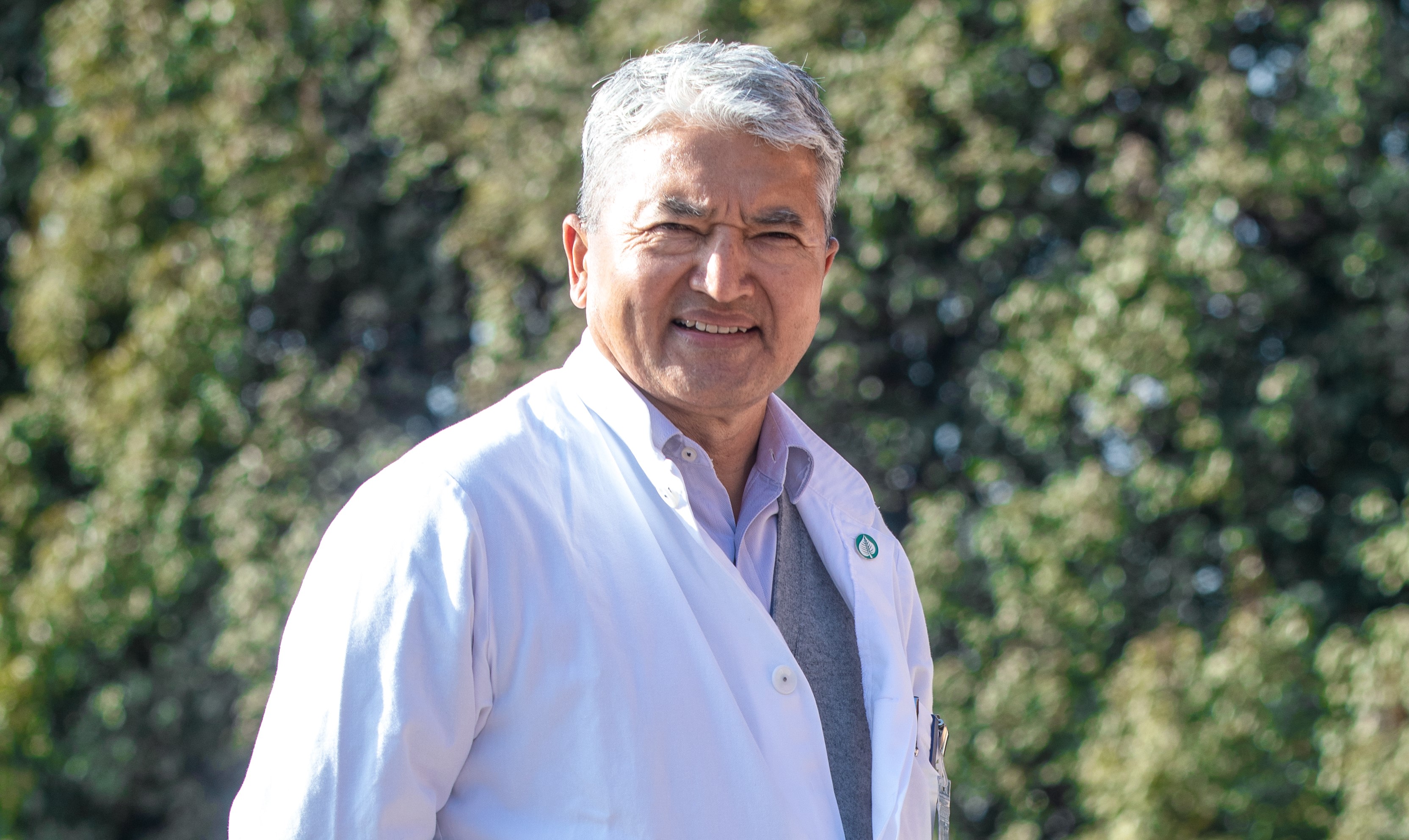Ashesh Malla: For the love of theater
Quick facts
Born on 3 April 1955 in Dhankuta
Went to Gokarneshwor High School, Dhankuta
Graduated from Mahendra Morang Campus, Post-grad from Tribhuvan University
Started drama from 1961
Husband of Sabitri Kakshyapati
Father to Sampada Malla and Avineet Malla
 Theater has always been a part of my family. I was born and raised in Dhankuta, but my ancestors were from Bhaktapur, a place steeped in art and culture. So, the element of theater and drama was always there in my family, no matter where they went. My family naturally had a profound influence on me during my formative years.
Every year we used to set up a huge stage for actors to perform their plays in Dhankuta. I used to see the actors rehearse, and sometimes I would get to play the role of a kid in the plays they were staging. I participated in jatras as well.
After completing my school, I left for Biratnagar for my further studies. But I would be back for a month or so during jatras.
I always knew what I wanted to do with my life, and all my family and friends were supportive of me. They used to encourage me to write my own plays and stage it in our village. They really believed in me. This was how the theater troupe called ‘Nawa Kalakar Sanskritik Samudaya’ was formed in 1974. I wrote my first play ‘Tuwalole Dhakeko Basti’ in 1975. The play was staged at my school, and surprisingly, we had a lot of audience.
Buoyed by the audience response, we took the play to Dharan. We booked a cinema hall there to perform the play. Next, we went to Biratnagar and to Kathmandu, where we performed at Rastriya Naach Ghar. In Kathmandu, our play was staged for one-month straight. It was a big deal for us, because it was our first play.
Most of my friends returned to Dhankuta after the play was over, but I decided to stay behind. I wanted to do something big in the field of theater, and Kathmandu was where I could pursue my dream.
I enrolled myself at Tribhuvan University (TU) for a master's degree in arts. I wasted no time making use of the university auditorium to stage plays. This was how my theater journey began in Kathmandu.
At the time, the country was still under the Panchayat regime. There was no freedom of expression. Speaking against the government was a criminal offense.
Theater has always been a part of my family. I was born and raised in Dhankuta, but my ancestors were from Bhaktapur, a place steeped in art and culture. So, the element of theater and drama was always there in my family, no matter where they went. My family naturally had a profound influence on me during my formative years.
Every year we used to set up a huge stage for actors to perform their plays in Dhankuta. I used to see the actors rehearse, and sometimes I would get to play the role of a kid in the plays they were staging. I participated in jatras as well.
After completing my school, I left for Biratnagar for my further studies. But I would be back for a month or so during jatras.
I always knew what I wanted to do with my life, and all my family and friends were supportive of me. They used to encourage me to write my own plays and stage it in our village. They really believed in me. This was how the theater troupe called ‘Nawa Kalakar Sanskritik Samudaya’ was formed in 1974. I wrote my first play ‘Tuwalole Dhakeko Basti’ in 1975. The play was staged at my school, and surprisingly, we had a lot of audience.
Buoyed by the audience response, we took the play to Dharan. We booked a cinema hall there to perform the play. Next, we went to Biratnagar and to Kathmandu, where we performed at Rastriya Naach Ghar. In Kathmandu, our play was staged for one-month straight. It was a big deal for us, because it was our first play.
Most of my friends returned to Dhankuta after the play was over, but I decided to stay behind. I wanted to do something big in the field of theater, and Kathmandu was where I could pursue my dream.
I enrolled myself at Tribhuvan University (TU) for a master's degree in arts. I wasted no time making use of the university auditorium to stage plays. This was how my theater journey began in Kathmandu.
At the time, the country was still under the Panchayat regime. There was no freedom of expression. Speaking against the government was a criminal offense.
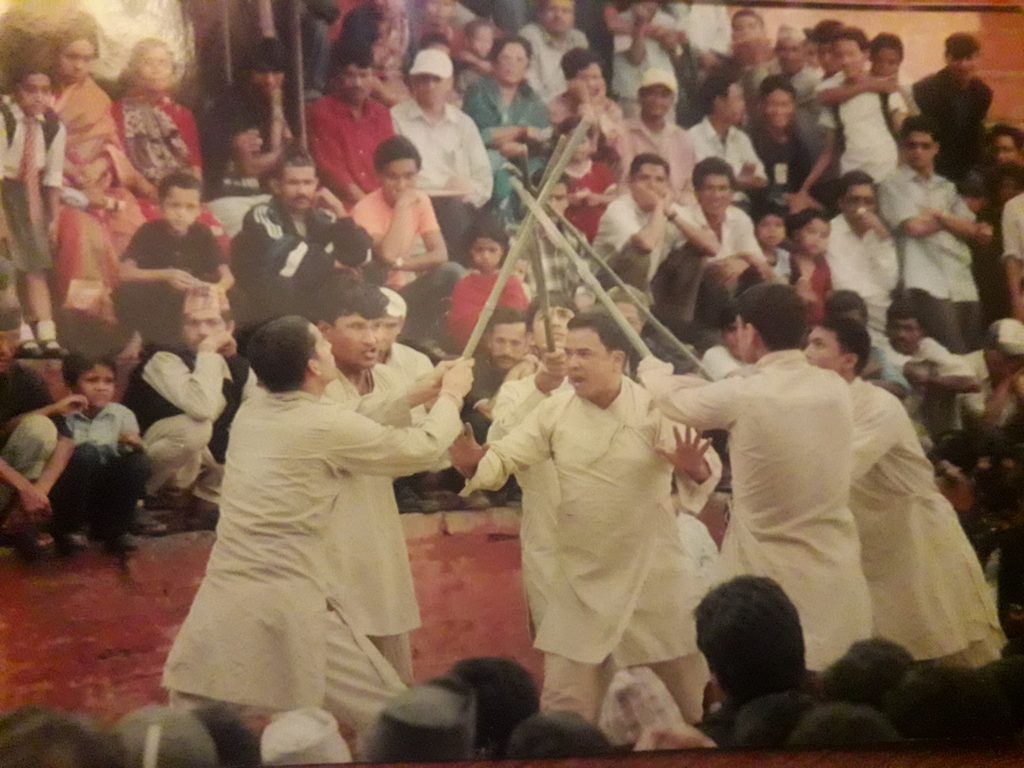 I was deeply affected when I heard that Bhim Narayan Shrestha, my neighbor from Dhankuta, had been sentenced to death for anti-government activities. The incident inspired me to write a play that satirized the political system of the time. When the play was staged, it angered the government to end. My theater team and I were assaulted behind the curtains for this transgression. But that didn’t stop us from speaking up against the Panchayat. I wrote another play, which was shut down on the third day of production. Such was the political scenario of Nepal. I rebelled against the powers that be and I was punished. I no longer had a stage to showcase my play. But I had a few university friends who were willing to help me out.
We needed our own place to freely work on plays. In 1982, we established Sarwanam Theater, but we still didn’t have a stage to perform our plays.
The government was not letting us perform. The district administration offices were censoring plays across the country. There was no place where we could freely express our thoughts and ideas through art. I increasingly grew hopeless when it occurred to me that I could perform my plays anywhere. All I needed was the audience. So I thought, “Why not just perform on the street?” This was how I came up with the concept of street theater (Sadak Natak).
I wrote a play called ‘Hami Basanta Khojirahechau’ and staged it at the coronation garden of TU. Almost every student loved it. We were invited by other colleges to perform the play. After that I also wrote plays like ‘Atirikta Aakash’ and ‘Ma Bhaneko Hami’. They were light dramas that indirectly reflected the then political scenario of Nepal.
Soon enough we were being asked to perform street dramas in many places. We went everywhere we could. Sometimes police would stop us while traveling. But that didn’t stop us from showcasing our plays.
Our street dramas played a key role in the 1990 revolution and even after that. Street dramas were part of every Nepali revolution and popular political movement. I didn’t know until late that street plays were popular in foreign countries as a form of protest as well.
After the restoration of democracy in 1990, street dramas went beyond political themes. There were street dramas with social messages and even commercial advertisements.
I stopped performing street plays after 1994, until the Election Commission requested me to write a play about the Constituent Assembly in 2008, which was to be showcased in all districts of Nepal on the same day and same time. I guess it could have been a world record.
When I look back at my career, I don’t know how I did it. I persevered despite the government threats and pressure. Perhaps my passion for theater arts got me through it all. That passion is still there.
I was deeply affected when I heard that Bhim Narayan Shrestha, my neighbor from Dhankuta, had been sentenced to death for anti-government activities. The incident inspired me to write a play that satirized the political system of the time. When the play was staged, it angered the government to end. My theater team and I were assaulted behind the curtains for this transgression. But that didn’t stop us from speaking up against the Panchayat. I wrote another play, which was shut down on the third day of production. Such was the political scenario of Nepal. I rebelled against the powers that be and I was punished. I no longer had a stage to showcase my play. But I had a few university friends who were willing to help me out.
We needed our own place to freely work on plays. In 1982, we established Sarwanam Theater, but we still didn’t have a stage to perform our plays.
The government was not letting us perform. The district administration offices were censoring plays across the country. There was no place where we could freely express our thoughts and ideas through art. I increasingly grew hopeless when it occurred to me that I could perform my plays anywhere. All I needed was the audience. So I thought, “Why not just perform on the street?” This was how I came up with the concept of street theater (Sadak Natak).
I wrote a play called ‘Hami Basanta Khojirahechau’ and staged it at the coronation garden of TU. Almost every student loved it. We were invited by other colleges to perform the play. After that I also wrote plays like ‘Atirikta Aakash’ and ‘Ma Bhaneko Hami’. They were light dramas that indirectly reflected the then political scenario of Nepal.
Soon enough we were being asked to perform street dramas in many places. We went everywhere we could. Sometimes police would stop us while traveling. But that didn’t stop us from showcasing our plays.
Our street dramas played a key role in the 1990 revolution and even after that. Street dramas were part of every Nepali revolution and popular political movement. I didn’t know until late that street plays were popular in foreign countries as a form of protest as well.
After the restoration of democracy in 1990, street dramas went beyond political themes. There were street dramas with social messages and even commercial advertisements.
I stopped performing street plays after 1994, until the Election Commission requested me to write a play about the Constituent Assembly in 2008, which was to be showcased in all districts of Nepal on the same day and same time. I guess it could have been a world record.
When I look back at my career, I don’t know how I did it. I persevered despite the government threats and pressure. Perhaps my passion for theater arts got me through it all. That passion is still there.
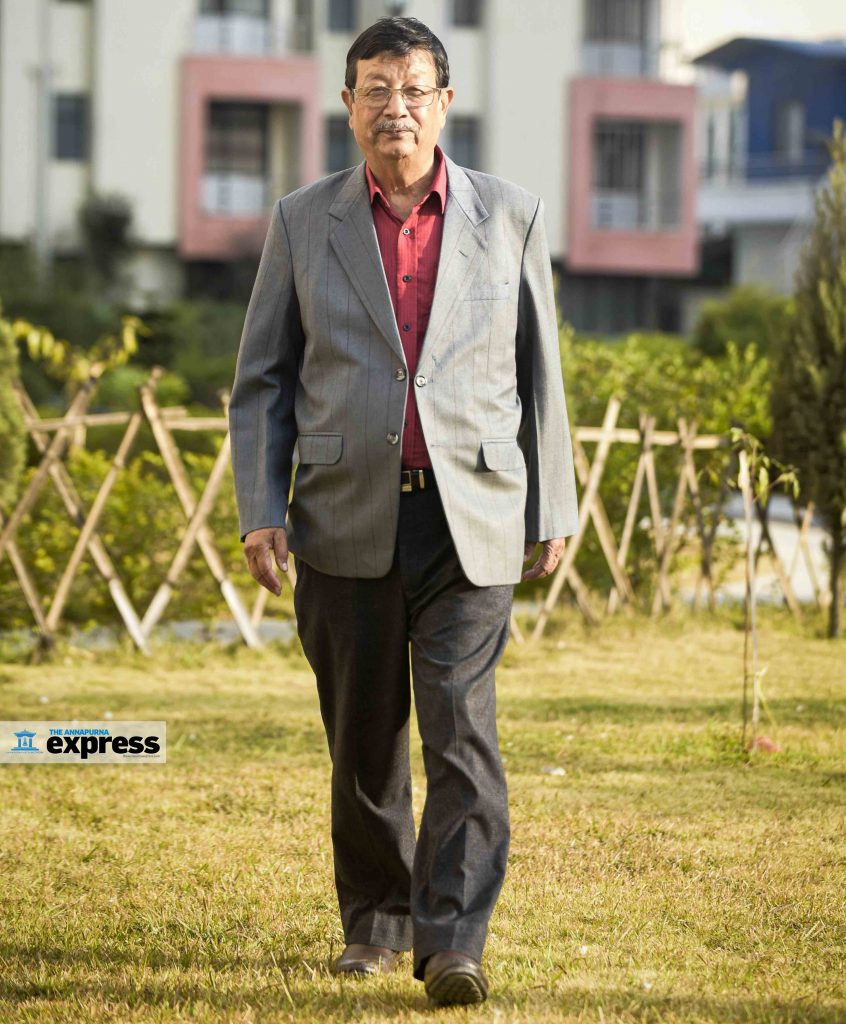 About him
Sabitri Kakshyapati (Spouse)
About him
Sabitri Kakshyapati (Spouse)
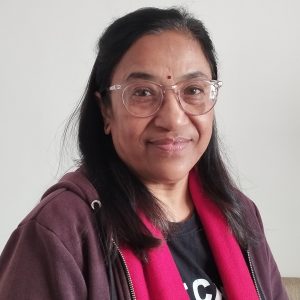 I don’t have to explain how good he is professionally, as the entire country has seen his work. In his personal life, he is a wonderful husband and a father. Being a working woman, I needed his support and he has always helped me with that. He doesn’t believe in patriarchy and is involved in kitchen works and all. He has always provided professional and personal space for his family members.
Harihar Sharma (Friend)
I don’t have to explain how good he is professionally, as the entire country has seen his work. In his personal life, he is a wonderful husband and a father. Being a working woman, I needed his support and he has always helped me with that. He doesn’t believe in patriarchy and is involved in kitchen works and all. He has always provided professional and personal space for his family members.
Harihar Sharma (Friend)
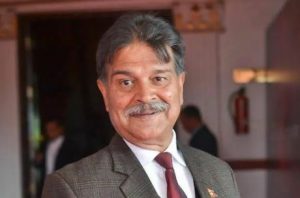 I have known him for a long time. I have seen his ups and downs in his personal and professional life. Despite the challenges in different political environments, he fought for democracy through his art. He is a revolutionary theater artist, a brilliant poet and a down-to-earth human. Being active in the profession for such a long time is not a joke and not everyone’s cup of tea.
Usha Rajak (Student)
I have known him for a long time. I have seen his ups and downs in his personal and professional life. Despite the challenges in different political environments, he fought for democracy through his art. He is a revolutionary theater artist, a brilliant poet and a down-to-earth human. Being active in the profession for such a long time is not a joke and not everyone’s cup of tea.
Usha Rajak (Student)
 Though I knew him during a theater competition around two decades ago, I was formally introduced to him only in 2018. He cast me for a lead role in his play ‘Arko Kurukshetra’ which was a theatrical comeback for both of us. He always expects great performances from his actors. With him, we get to explore the philosophy of classics like Mahabharat and modern day activism too. Despite being a celebrated theater figure, he is humble and has made theater available for everyone.
Though I knew him during a theater competition around two decades ago, I was formally introduced to him only in 2018. He cast me for a lead role in his play ‘Arko Kurukshetra’ which was a theatrical comeback for both of us. He always expects great performances from his actors. With him, we get to explore the philosophy of classics like Mahabharat and modern day activism too. Despite being a celebrated theater figure, he is humble and has made theater available for everyone.
Dr Ram Kantha Makaju Shrestha: Man who started an exemplary hospital
Quick facts
Born on May 1960 in Dhulikhel
Went to Sanjiwani School, Dhulikhel
Completed Doctor of Medicine from University of Vienna, Austria
Completed Specialization in Surgery from Hospital of Vorarlberg, Austria
Established Dhulikhel Hospital in 1996
 When I lost my mother at the age of 10, I didn’t understand why she died. As I grew older, I became obsessed with the idea of saving people from their sufferings. What a wonderful impact it would be to them as well as their families? I never had a doubt about the choice of my career. I wanted to become a doctor. It was almost an impossible dream because I was born and raised in a small village. But I never gave up on my dream.
I completed my intermediate in science (Isc) from Amrit Science College in Kathmandu and reached out to various international institutions so that I could study medicine. I was finally accepted by the University of Vienna. The 15 years I spent in Austria was a transformative time for me. I consider myself fortunate to have received the opportunity of going to a prestigious university. Besides academic learning, I also learned a lot from the people, culture and institutions there.
Of course, there were challenges, especially due to the language barrier, but I overcame them by sheer dint of hard work. If you desire something strongly enough and commit to it, nothing will be insurmountable. My decision to return to Nepal and start a hospital was founded on my childhood dream of helping those who are suffering. I didn’t have resources to open a hospital, but what I had was the determination and the goodwill of many friends. Dhulikhel Hospital started as a pioneering community hospital in Nepal with the vision of imparting quality health service to the poor. We were the first institution that provided high quality service to all, irrespective of their financial background..
To this day, we have been working with the same spirit. We now run not just the central Dhulikhel Hospital, but also 18 rural outreach centers across Nepal. Through these centers we provide basic healthcare services and run programs related to community development and holistic approach to health. We also work closely with the government and other organizations to enhance healthcare through training and other partnership programs.
Today, Dhulikhel Hospital serves around 700,000 patients every year. We have managed to build centers of excellence in several specialties and are on our way of expanding them. Nothing is more gratifying than to see that our own team delivers world-class services. We are also engaged in quality education in the field of health sciences and cutting-edge research works.
All of this was made possible by our outstanding, dedicated team of about 1700 people. We work together as a family. Our approach is simple: Do little good every day and the larger things will take care of themselves. We faced many challenges and survived them with this simple approach. Our team came together and worked relentlessly during the 2015 earthquake and Covid-19 pandemic. We faced severe financial hardship during the pandemic, but we didn’t lay off a single staff. Instead, we chose to share whatever resources we had. The bond, affection and care between the team members is our greatest strength. Our well-wishers and supporters from Nepal and abroad have been our greatest assets.
I also worked as the vice-chancellor of Kathmandu University for eight years. This experience gave me the opportunity to contribute to the field of education and take the varsity to newer heights. I believe there is a lot we have to do to improve the education sector and link it to the employment opportunities and entrepreneurship, so that the Nepali youths get the chance to learn and earn here in their own country, rather than go toil in foreign lands. It pains me seeing young Nepalis leave the country for employment.
Overall, I am an optimistic person, who believes that Nepalis can do great things in Nepal itself. To anyone who disagrees, I tell them to come visit Dhulikhel Hospital. Nepal is a beautiful country and the people here are amazing. What we need is to build teams and organizations with clarity of vision, culture of care and collaboration, and finally, the incessant pursuit for excellence.
[caption id="attachment_35907" align="alignnone" width="1024"]
When I lost my mother at the age of 10, I didn’t understand why she died. As I grew older, I became obsessed with the idea of saving people from their sufferings. What a wonderful impact it would be to them as well as their families? I never had a doubt about the choice of my career. I wanted to become a doctor. It was almost an impossible dream because I was born and raised in a small village. But I never gave up on my dream.
I completed my intermediate in science (Isc) from Amrit Science College in Kathmandu and reached out to various international institutions so that I could study medicine. I was finally accepted by the University of Vienna. The 15 years I spent in Austria was a transformative time for me. I consider myself fortunate to have received the opportunity of going to a prestigious university. Besides academic learning, I also learned a lot from the people, culture and institutions there.
Of course, there were challenges, especially due to the language barrier, but I overcame them by sheer dint of hard work. If you desire something strongly enough and commit to it, nothing will be insurmountable. My decision to return to Nepal and start a hospital was founded on my childhood dream of helping those who are suffering. I didn’t have resources to open a hospital, but what I had was the determination and the goodwill of many friends. Dhulikhel Hospital started as a pioneering community hospital in Nepal with the vision of imparting quality health service to the poor. We were the first institution that provided high quality service to all, irrespective of their financial background..
To this day, we have been working with the same spirit. We now run not just the central Dhulikhel Hospital, but also 18 rural outreach centers across Nepal. Through these centers we provide basic healthcare services and run programs related to community development and holistic approach to health. We also work closely with the government and other organizations to enhance healthcare through training and other partnership programs.
Today, Dhulikhel Hospital serves around 700,000 patients every year. We have managed to build centers of excellence in several specialties and are on our way of expanding them. Nothing is more gratifying than to see that our own team delivers world-class services. We are also engaged in quality education in the field of health sciences and cutting-edge research works.
All of this was made possible by our outstanding, dedicated team of about 1700 people. We work together as a family. Our approach is simple: Do little good every day and the larger things will take care of themselves. We faced many challenges and survived them with this simple approach. Our team came together and worked relentlessly during the 2015 earthquake and Covid-19 pandemic. We faced severe financial hardship during the pandemic, but we didn’t lay off a single staff. Instead, we chose to share whatever resources we had. The bond, affection and care between the team members is our greatest strength. Our well-wishers and supporters from Nepal and abroad have been our greatest assets.
I also worked as the vice-chancellor of Kathmandu University for eight years. This experience gave me the opportunity to contribute to the field of education and take the varsity to newer heights. I believe there is a lot we have to do to improve the education sector and link it to the employment opportunities and entrepreneurship, so that the Nepali youths get the chance to learn and earn here in their own country, rather than go toil in foreign lands. It pains me seeing young Nepalis leave the country for employment.
Overall, I am an optimistic person, who believes that Nepalis can do great things in Nepal itself. To anyone who disagrees, I tell them to come visit Dhulikhel Hospital. Nepal is a beautiful country and the people here are amazing. What we need is to build teams and organizations with clarity of vision, culture of care and collaboration, and finally, the incessant pursuit for excellence.
[caption id="attachment_35907" align="alignnone" width="1024"]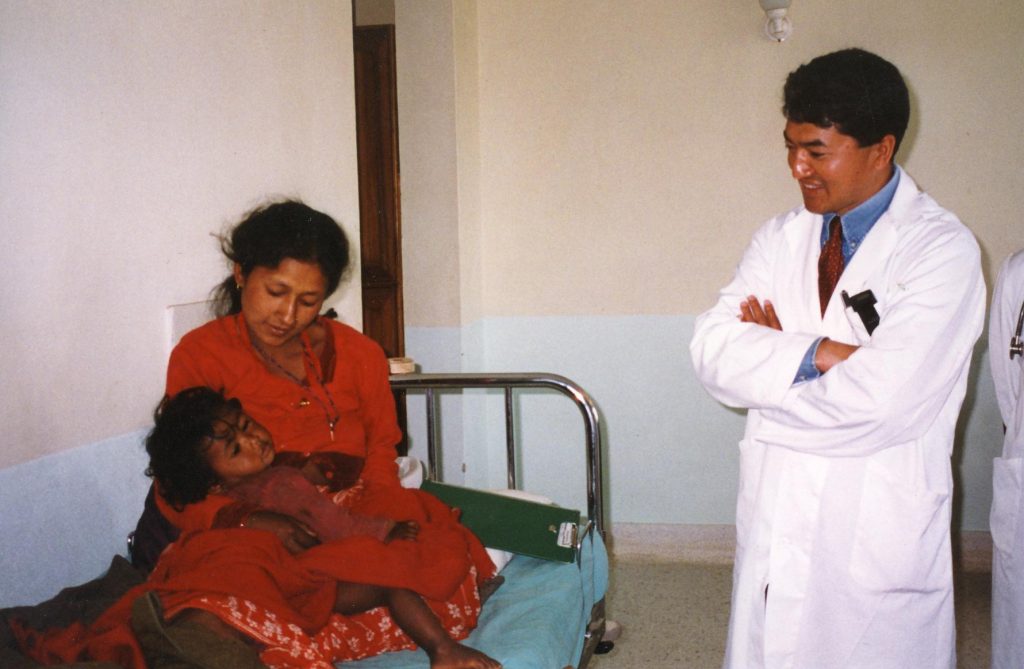 Dr Ram Kantha Makaju Shrestha with a patient during the initial days of Dhulikhel Hospital.[/caption]
About him
Bel Prasad Shrestha (Cousin)
Dr Ram Kantha Makaju Shrestha with a patient during the initial days of Dhulikhel Hospital.[/caption]
About him
Bel Prasad Shrestha (Cousin)
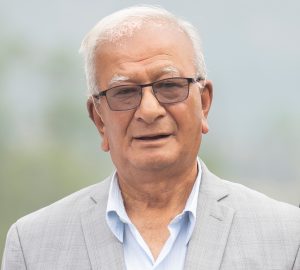 He has been different since his childhood. He always excelled in whatever he did. Dhulikhel Hospital would not have opened if not for his determination to build a good medical facility for the disadvantaged. No one thought this institution would be this huge and serve millions of people one day. Then again, he is a man for whom the sky’s the limit. He continues to surprise and inspire us all.
Dr Rajendra Koju (Colleague)
He has been different since his childhood. He always excelled in whatever he did. Dhulikhel Hospital would not have opened if not for his determination to build a good medical facility for the disadvantaged. No one thought this institution would be this huge and serve millions of people one day. Then again, he is a man for whom the sky’s the limit. He continues to surprise and inspire us all.
Dr Rajendra Koju (Colleague)
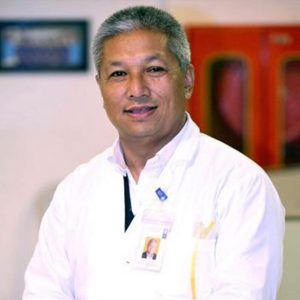 Dr. Ram was a senior at my school. From the school days, I thought he was destined to do something great. You could see that he was not like other students. It has been a great pleasure and honor for me to work alongside him at Dhulikhel Hospital. The journey we have had has been nothing short of spectacular. He is my friend, a mentor, a person who deserves all the love and respect.
Dirgha Raj Shrestha (Friend)
Dr. Ram was a senior at my school. From the school days, I thought he was destined to do something great. You could see that he was not like other students. It has been a great pleasure and honor for me to work alongside him at Dhulikhel Hospital. The journey we have had has been nothing short of spectacular. He is my friend, a mentor, a person who deserves all the love and respect.
Dirgha Raj Shrestha (Friend)
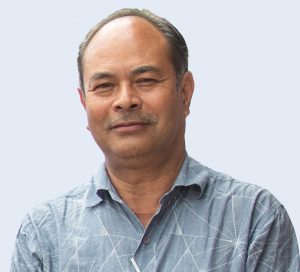 He is a visionary in my eyes, a hardworking and committed person with a big dream. He leads others by example. His dedication and diligence motivate the people around him. He is a man of strong character and capacity to make his dream projects come true. I admire his commitment to provide quality healthcare to the poor and marginalized communities.
He is a visionary in my eyes, a hardworking and committed person with a big dream. He leads others by example. His dedication and diligence motivate the people around him. He is a man of strong character and capacity to make his dream projects come true. I admire his commitment to provide quality healthcare to the poor and marginalized communities.
Gagan Pradhan: The man who introduced coffee culture in Nepal
Quick facts
Born on 15 Nov 1974 in Bhaktapur
Went to Siddhartha Vanasthali School
Graduated in Hospitality Management from William Blue Int’l Hotel Management School, Australia
Opened first outlet of Himalayan Java at Heritage Plaza, Kamaladi, in 1999
Husband of Nupur Pradhan
Father to Gaurav Pradhan and Nirosha Pradhan
 Until the late 90s, Nepal had no real coffee shops. Coffee meant instant coffee back then, and that too could only be found in a few hotels and restaurants.
I saw what coffee shops look like and how coffee tastes while I was in Australia for my studies. It was decided that I would return to Nepal after my studies, but I had no concrete plan regarding my career. I came to Nepal with a degree in hospitality management after five years, and started working for a prestigious hotel in Kathmandu. It was while working at this hotel that I realized that I was not meant to be a salaried worker. Even though I was being paid handsomely, I quit the hotel job within a week.
I wanted to start a business. For me, a business should be something innovative, or else you are doing the same as everyone else. Without a unique touch, a business can't make any difference in the market. So, I started visiting different places in Kathmandu, trying to figure out what I could do. It was a market research of sorts, where I asked a variety of questions to people from different walks of life. This is how I came up with the idea of starting a coffee shop. Many people were positive about having a coffee shop in the town and they promised to visit it if I opened one.
So, with a plan of starting a coffee shop, I went to the US and signed up for barista training. When I returned, I also brought along a coffee machine with me. It was the first coffee machine in Nepal.
With an investment of around Rs 1.3m, I opened the first Himalayan Java at Heritage Plaza, Kamaladi. I hired a few youths and trained them to prepare and serve coffee. I worked with them and did everything an employee has to do. I even dropped off my employees at their homes after work. We worked as a team. We discussed all work-related problems and sought their solutions.
In the early days, the setting and ambience of our shop used to confuse many of our clients. Since the setup was well furnished with couches, comfortable chairs and beautiful lighting, many people mistook Himalayan Java for a furniture store. Others thought we were running a computer-training center because of the word ‘Java’, a computer language. People didn’t know that java is a synonym for coffee.
Sustaining the business became a big issue for us because coffee had yet to seep into our culture. So, one day we decided to shift our establishment to Thamel, as the place saw heavy tourist footfall.
From then on we had a steady rise in the number of customers. It was mostly foreigners at first. Then came Nepalis who had lived overseas, who also brought their family and friends to our shop.
Though Himalayan Java was not doing a great business in its initial days, it never compromised on the quality of its products and service. It was not compulsory for our clients to order a drink. They could just visit us to spend their time inside.
All these things helped build our client numbers. It was them who did the marketing for us. Had I rushed things and followed a different path, I would not have contributed to establishing a coffee culture in Nepal. With time, we were able to expand our outlets. These days, coffee has become a part of life for many of us.
Coffee is a cash crop that is not easy to grow. Its production takes around seven years, so it is a long-term investment. And since the government does not offer any subsidies for coffee farming, Nepali farmers are not interested in coffee cultivation. This is despite the fact that Nepali coffee is one of the best in the world.
The annual consumption of coffee in Nepal is 10,000 metric tons. To fulfill this demand, Nepal imports coffee from India, Italy, Thailand, and Indonesia. If we were to improve Nepali production, this import could easily be ended and we could even export our coffee in the global market.
Himalayan Java started off as the first coffee shop in Nepal to specialize in handcrafted coffee and bakery and over the years, we have diversified from a small coffee shop to an international franchising Nepali coffee brand with 43 outlets around the world. In 2017, we started selling our franchise. Out of 43 outlets, my team currently owns 13.
I have always believed in maintaining a sustainable business ecosystem by supporting local farmers and Nepali products. Through continuous innovation in technology and process, we hope to become the most inspiring Nepali coffee establishment in the world. My goal is to take Nepali coffee and culture to the world.
To help the coffee culture flourish in Nepal, we not only serve coffee but also sell coffee machines and equipment, and offer essential barista training. I never see other coffee shops as my rivals. I happily invite them and share what I know about this industry, because I feel like a new coffee shop can help this culture grow.
About him
Dip Lama (Friend)
Until the late 90s, Nepal had no real coffee shops. Coffee meant instant coffee back then, and that too could only be found in a few hotels and restaurants.
I saw what coffee shops look like and how coffee tastes while I was in Australia for my studies. It was decided that I would return to Nepal after my studies, but I had no concrete plan regarding my career. I came to Nepal with a degree in hospitality management after five years, and started working for a prestigious hotel in Kathmandu. It was while working at this hotel that I realized that I was not meant to be a salaried worker. Even though I was being paid handsomely, I quit the hotel job within a week.
I wanted to start a business. For me, a business should be something innovative, or else you are doing the same as everyone else. Without a unique touch, a business can't make any difference in the market. So, I started visiting different places in Kathmandu, trying to figure out what I could do. It was a market research of sorts, where I asked a variety of questions to people from different walks of life. This is how I came up with the idea of starting a coffee shop. Many people were positive about having a coffee shop in the town and they promised to visit it if I opened one.
So, with a plan of starting a coffee shop, I went to the US and signed up for barista training. When I returned, I also brought along a coffee machine with me. It was the first coffee machine in Nepal.
With an investment of around Rs 1.3m, I opened the first Himalayan Java at Heritage Plaza, Kamaladi. I hired a few youths and trained them to prepare and serve coffee. I worked with them and did everything an employee has to do. I even dropped off my employees at their homes after work. We worked as a team. We discussed all work-related problems and sought their solutions.
In the early days, the setting and ambience of our shop used to confuse many of our clients. Since the setup was well furnished with couches, comfortable chairs and beautiful lighting, many people mistook Himalayan Java for a furniture store. Others thought we were running a computer-training center because of the word ‘Java’, a computer language. People didn’t know that java is a synonym for coffee.
Sustaining the business became a big issue for us because coffee had yet to seep into our culture. So, one day we decided to shift our establishment to Thamel, as the place saw heavy tourist footfall.
From then on we had a steady rise in the number of customers. It was mostly foreigners at first. Then came Nepalis who had lived overseas, who also brought their family and friends to our shop.
Though Himalayan Java was not doing a great business in its initial days, it never compromised on the quality of its products and service. It was not compulsory for our clients to order a drink. They could just visit us to spend their time inside.
All these things helped build our client numbers. It was them who did the marketing for us. Had I rushed things and followed a different path, I would not have contributed to establishing a coffee culture in Nepal. With time, we were able to expand our outlets. These days, coffee has become a part of life for many of us.
Coffee is a cash crop that is not easy to grow. Its production takes around seven years, so it is a long-term investment. And since the government does not offer any subsidies for coffee farming, Nepali farmers are not interested in coffee cultivation. This is despite the fact that Nepali coffee is one of the best in the world.
The annual consumption of coffee in Nepal is 10,000 metric tons. To fulfill this demand, Nepal imports coffee from India, Italy, Thailand, and Indonesia. If we were to improve Nepali production, this import could easily be ended and we could even export our coffee in the global market.
Himalayan Java started off as the first coffee shop in Nepal to specialize in handcrafted coffee and bakery and over the years, we have diversified from a small coffee shop to an international franchising Nepali coffee brand with 43 outlets around the world. In 2017, we started selling our franchise. Out of 43 outlets, my team currently owns 13.
I have always believed in maintaining a sustainable business ecosystem by supporting local farmers and Nepali products. Through continuous innovation in technology and process, we hope to become the most inspiring Nepali coffee establishment in the world. My goal is to take Nepali coffee and culture to the world.
To help the coffee culture flourish in Nepal, we not only serve coffee but also sell coffee machines and equipment, and offer essential barista training. I never see other coffee shops as my rivals. I happily invite them and share what I know about this industry, because I feel like a new coffee shop can help this culture grow.
About him
Dip Lama (Friend)
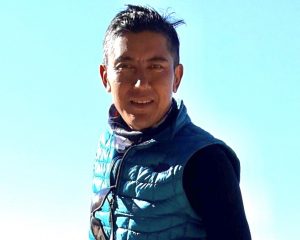 It is difficult to critically describe one of my very good friends as I have not found any flaws in him—neither as a professional person, nor as a friend. If he wanted to be an ordinary businessperson, there were many easy ways for him, but he wanted to establish a culture in this country. And what a job he has done!
Dr Niraj Lal Baidya (Friend)
It is difficult to critically describe one of my very good friends as I have not found any flaws in him—neither as a professional person, nor as a friend. If he wanted to be an ordinary businessperson, there were many easy ways for him, but he wanted to establish a culture in this country. And what a job he has done!
Dr Niraj Lal Baidya (Friend)
 Gagan has been my neighbor for around six years. We became very good friends from the day we met. Besides being a confident, intelligent, and careful decision-maker in his business, he is also a kind-hearted human being. He cares for his staff and has built a strong team, which I think is the secret to his success.
Prakash Lal Malla (Uncle)
Gagan has been my neighbor for around six years. We became very good friends from the day we met. Besides being a confident, intelligent, and careful decision-maker in his business, he is also a kind-hearted human being. He cares for his staff and has built a strong team, which I think is the secret to his success.
Prakash Lal Malla (Uncle)
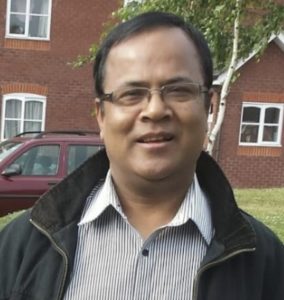 He is a hard-working and ambitious person. These traits have helped him become a successful businessman. I have seen success get to many people’s heads, not Gagan. He has always been a down-to-earth person. He spends plenty of time with his family and friends, guiding them when they are in need. Besides being a family man, he is also a good role model and a mentor.
He is a hard-working and ambitious person. These traits have helped him become a successful businessman. I have seen success get to many people’s heads, not Gagan. He has always been a down-to-earth person. He spends plenty of time with his family and friends, guiding them when they are in need. Besides being a family man, he is also a good role model and a mentor.
Capt Rabindra Prasad Pradhan: A man of many firsts
Quick facts
Born on 17 March 1940 in Palpa
Went to Palpa High School
First flying training from CATC, India in 1960
First helicopter training from ASTATCC, Russia in 1965
Started flights from 1963
Husband of Renu Pradhan
 In my 32 years of flying career from 1963 to 1995, I set an incident/accident-free record, a rare achievement for any pilot. Not only this, but my career has a list of many firsts.
When I joined the Royal Nepal Airlines Corporation (RNAC) my pilot license number was 006, meaning there were only five pilots before me in Nepal. Back then flights were not popular in South Asia, especially in Nepal, so there were few pilots.
Before me there were no helicopter pilots in Nepal. I was fortunate enough to get a helicopter-flying license courtesy of the government that sent me to Russia for training. That way I became the first helicopter pilot of Nepal.
In 1972, I was deployed to Royal Air Flight, the flight department of the Nepal Army that used to fly the royal family. I still kept my RNAC job though, because I had to be flying regularly to ensure the validity of my pilot license. For nearly 29 years, I flew both commercial airplanes and helicopters. This was something that had never been done in aviation history. This record can’t be beaten since the International Civil Aviation Organization (ICAO) later banned pilots from flying both planes and helicopters.
Flying fixed-wing (airplane) and rotary-wing (helicopter) aircraft simultaneously on commercial operations is considered unique because the two aircraft function differently. I had the opportunity to fly both aircraft as part of my regular job because the then government allowed me to do so.
I am also the first pilot to land a commercial cargo flight in Everest base camp. I also made a record for the highest helicopter rescue at 20,800ft in the Langtang region.
[caption id="attachment_35336" align="alignnone" width="995"]
In my 32 years of flying career from 1963 to 1995, I set an incident/accident-free record, a rare achievement for any pilot. Not only this, but my career has a list of many firsts.
When I joined the Royal Nepal Airlines Corporation (RNAC) my pilot license number was 006, meaning there were only five pilots before me in Nepal. Back then flights were not popular in South Asia, especially in Nepal, so there were few pilots.
Before me there were no helicopter pilots in Nepal. I was fortunate enough to get a helicopter-flying license courtesy of the government that sent me to Russia for training. That way I became the first helicopter pilot of Nepal.
In 1972, I was deployed to Royal Air Flight, the flight department of the Nepal Army that used to fly the royal family. I still kept my RNAC job though, because I had to be flying regularly to ensure the validity of my pilot license. For nearly 29 years, I flew both commercial airplanes and helicopters. This was something that had never been done in aviation history. This record can’t be beaten since the International Civil Aviation Organization (ICAO) later banned pilots from flying both planes and helicopters.
Flying fixed-wing (airplane) and rotary-wing (helicopter) aircraft simultaneously on commercial operations is considered unique because the two aircraft function differently. I had the opportunity to fly both aircraft as part of my regular job because the then government allowed me to do so.
I am also the first pilot to land a commercial cargo flight in Everest base camp. I also made a record for the highest helicopter rescue at 20,800ft in the Langtang region.
[caption id="attachment_35336" align="alignnone" width="995"]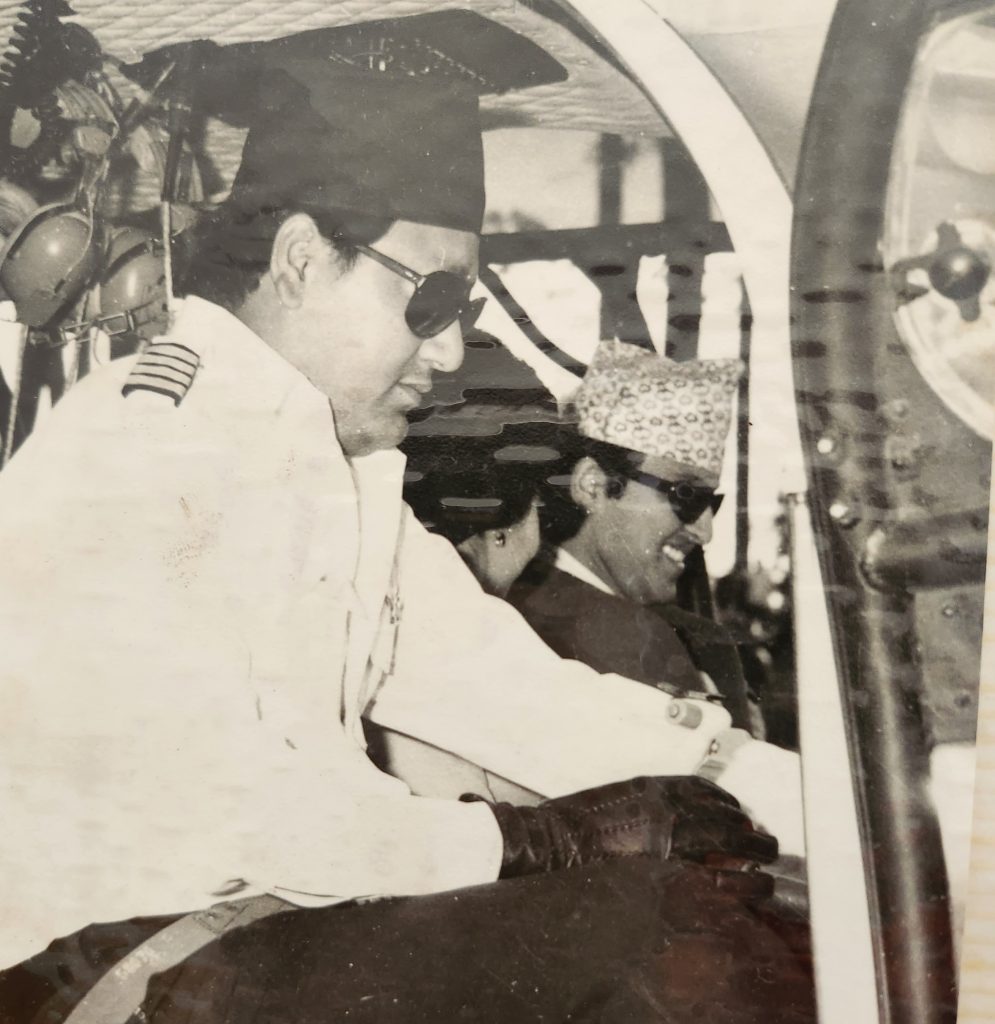 Capt Pradhan with the then royal family in a helicopter cockpit.[/caption]
From the time King Birendra ascended to the throne in 1972 till my retirement in 1995, I piloted all royal helicopter flights for 24 years. No other person in the world holds the record of flying the head of state for such a long time. I also flew the 9th, 10th, 11th, and 12th generations of the Shah dynasty. I have also flown prime ministers and royalties of other nations during their visits to Nepal.
Before 1980 all overseas tours of the king were undertaken on chartered jets of RNAC. But the people in the airlines management team were more focused on ensuring the in-flight comfort of the monarch and not so much on flight safety. King Birendra, being a pilot himself (he had completed a helicopter training course), was aware of these lapses, so he appointed me as the commander of VVIP flights in 1980.
During my career as a pilot, I also scouted locations for almost two dozen airports. Whenever the government wanted an airport built, it was my job to fly over the respective district and locate a suitable place.
I also helped the Civil Aviation Authority of Nepal (CAAN) draft rules and regulations for starting a private airline company in line with the government’s plan to expand Nepali aviation sector.
Aviation was a new sector back then and there were hardly anyone who wanted to invest in it. So, I decided to apply for the first private airline in the country. It was called Nepal Air Charter Service, which was later renamed Everest Air. I wanted to encourage others to get involved in the airlines business.
I established Cosmic Air in 1997 after RNAC along with other airlines were unable to fulfill the demand for flights. We did a good business and in 2001, we expanded our flights outside the country as well. Cosmic Air became the first private airlines company in Nepal to start international flights. As soon as we entered the market, a couple of Indian airlines had to reduce their flights to Nepal, as passengers preferred us over them.
What an incredible journey I’ve had working as a pilot. It was a dream career for me ever since I saw an aircraft taking off from the grassy runway in Bhairahawa for the first time in my life.
I had no idea that the dream I held as a little boy would someday turn into reality. I feel incredibly blessed and honored for all of this. I did work hard at my job and faced many professional setbacks and difficulties, but I do not wish to dwell on the negatives. Those things pale in comparison to the life I have had as a pilot.
Capt Pradhan with the then royal family in a helicopter cockpit.[/caption]
From the time King Birendra ascended to the throne in 1972 till my retirement in 1995, I piloted all royal helicopter flights for 24 years. No other person in the world holds the record of flying the head of state for such a long time. I also flew the 9th, 10th, 11th, and 12th generations of the Shah dynasty. I have also flown prime ministers and royalties of other nations during their visits to Nepal.
Before 1980 all overseas tours of the king were undertaken on chartered jets of RNAC. But the people in the airlines management team were more focused on ensuring the in-flight comfort of the monarch and not so much on flight safety. King Birendra, being a pilot himself (he had completed a helicopter training course), was aware of these lapses, so he appointed me as the commander of VVIP flights in 1980.
During my career as a pilot, I also scouted locations for almost two dozen airports. Whenever the government wanted an airport built, it was my job to fly over the respective district and locate a suitable place.
I also helped the Civil Aviation Authority of Nepal (CAAN) draft rules and regulations for starting a private airline company in line with the government’s plan to expand Nepali aviation sector.
Aviation was a new sector back then and there were hardly anyone who wanted to invest in it. So, I decided to apply for the first private airline in the country. It was called Nepal Air Charter Service, which was later renamed Everest Air. I wanted to encourage others to get involved in the airlines business.
I established Cosmic Air in 1997 after RNAC along with other airlines were unable to fulfill the demand for flights. We did a good business and in 2001, we expanded our flights outside the country as well. Cosmic Air became the first private airlines company in Nepal to start international flights. As soon as we entered the market, a couple of Indian airlines had to reduce their flights to Nepal, as passengers preferred us over them.
What an incredible journey I’ve had working as a pilot. It was a dream career for me ever since I saw an aircraft taking off from the grassy runway in Bhairahawa for the first time in my life.
I had no idea that the dream I held as a little boy would someday turn into reality. I feel incredibly blessed and honored for all of this. I did work hard at my job and faced many professional setbacks and difficulties, but I do not wish to dwell on the negatives. Those things pale in comparison to the life I have had as a pilot.
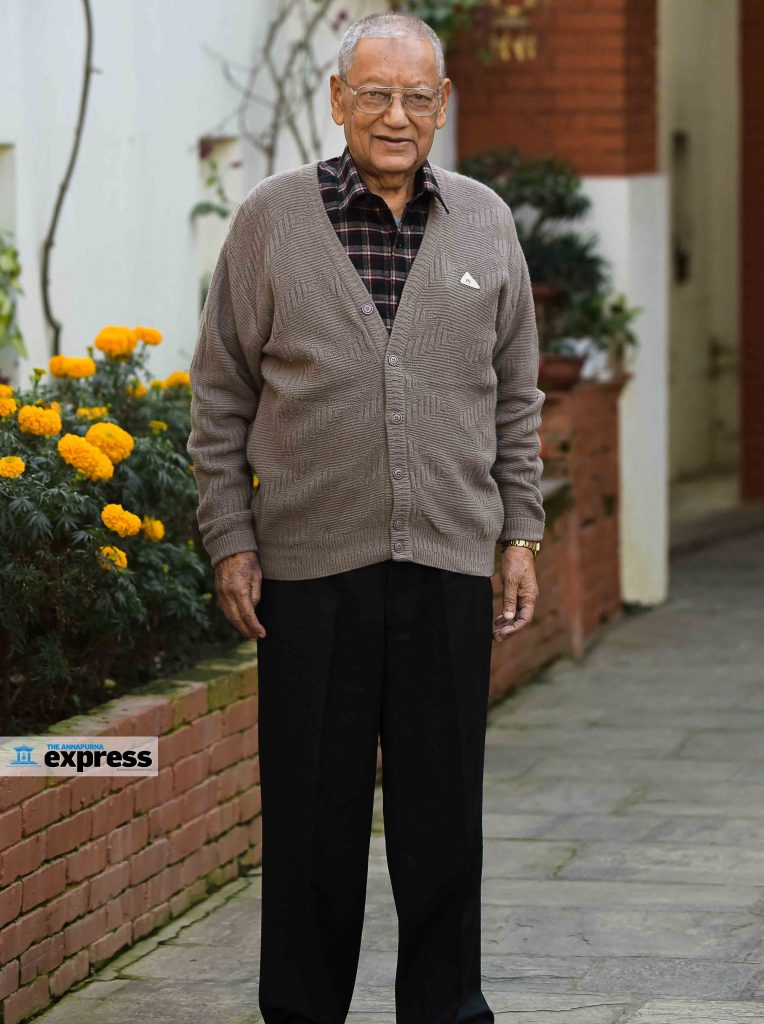 About him
Capt Sunil Pradhan (Nephew)
About him
Capt Sunil Pradhan (Nephew)
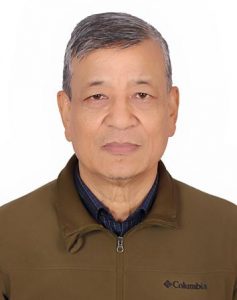 My uncle is my role model. I became a pilot, all thanks to him. He has inspired so many people in the aviation industry. When I arrived in Kathmandu, he helped me in every step of my life, from school to flight training. Although he was busy with his work, he always made time to help and instruct us in our career. Many might not know, he is also a spiritual person. He has written books on spirituality. This shows he is a compassionate human, always supportive of those who need help and guidance.
Capt Rameshwar Thapa (Mentee)
My uncle is my role model. I became a pilot, all thanks to him. He has inspired so many people in the aviation industry. When I arrived in Kathmandu, he helped me in every step of my life, from school to flight training. Although he was busy with his work, he always made time to help and instruct us in our career. Many might not know, he is also a spiritual person. He has written books on spirituality. This shows he is a compassionate human, always supportive of those who need help and guidance.
Capt Rameshwar Thapa (Mentee)
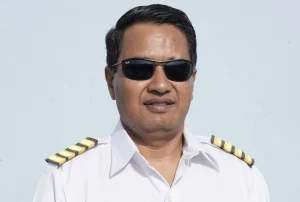 As I began my career as a pilot from his company, I consider him as a mentor and a father figure. It was him who came up with the open-sky policy in Nepal, so one can say that our aviation industry is still intact due to his foundational ideas. The first private airlines company that he established helped promote Nepali aviation sector. He has a wealth of knowledge in the field of aviation, so we have many things to learn from him.
Nagendra Prasad Ghimire (Colleague)
As I began my career as a pilot from his company, I consider him as a mentor and a father figure. It was him who came up with the open-sky policy in Nepal, so one can say that our aviation industry is still intact due to his foundational ideas. The first private airlines company that he established helped promote Nepali aviation sector. He has a wealth of knowledge in the field of aviation, so we have many things to learn from him.
Nagendra Prasad Ghimire (Colleague)
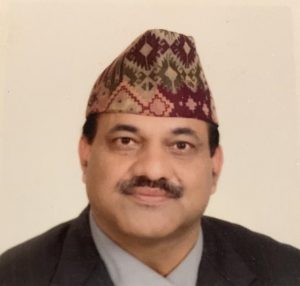 He is a soft-spoken but frank person. His achievements as a pilot are legendary. No wonder pilots aspire to have a flying career like his, no matter how far-fetched it seems. He is invested in improving the aviation sector to this day. That shows his love and dedication to this field. He often talks to me about the ways to improve Nepal’s aviation sector. He also had plans for the Lumbini Airport project. His suggestions were always valuable.
He is a soft-spoken but frank person. His achievements as a pilot are legendary. No wonder pilots aspire to have a flying career like his, no matter how far-fetched it seems. He is invested in improving the aviation sector to this day. That shows his love and dedication to this field. He often talks to me about the ways to improve Nepal’s aviation sector. He also had plans for the Lumbini Airport project. His suggestions were always valuable.







